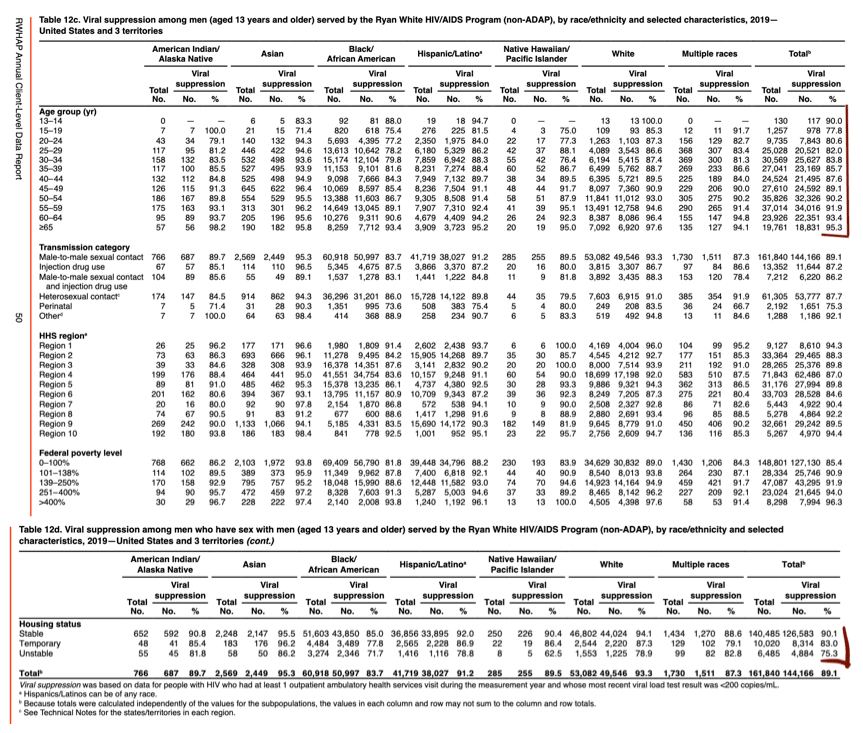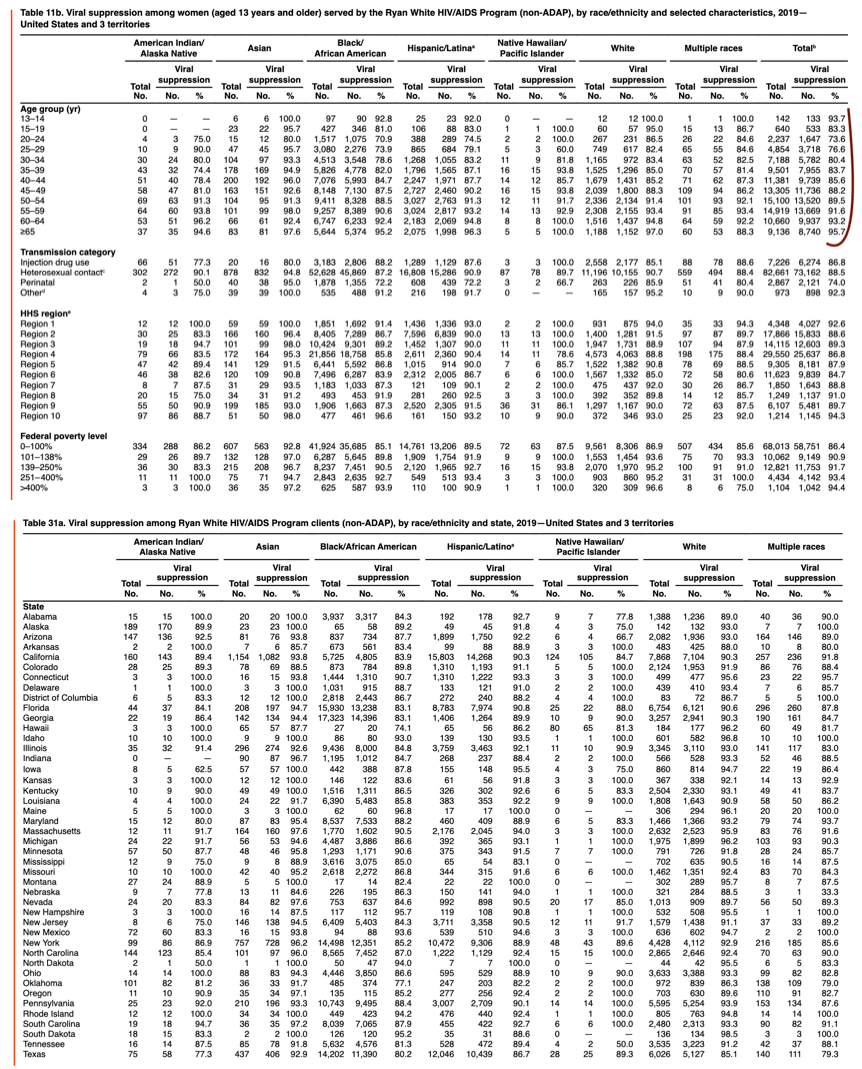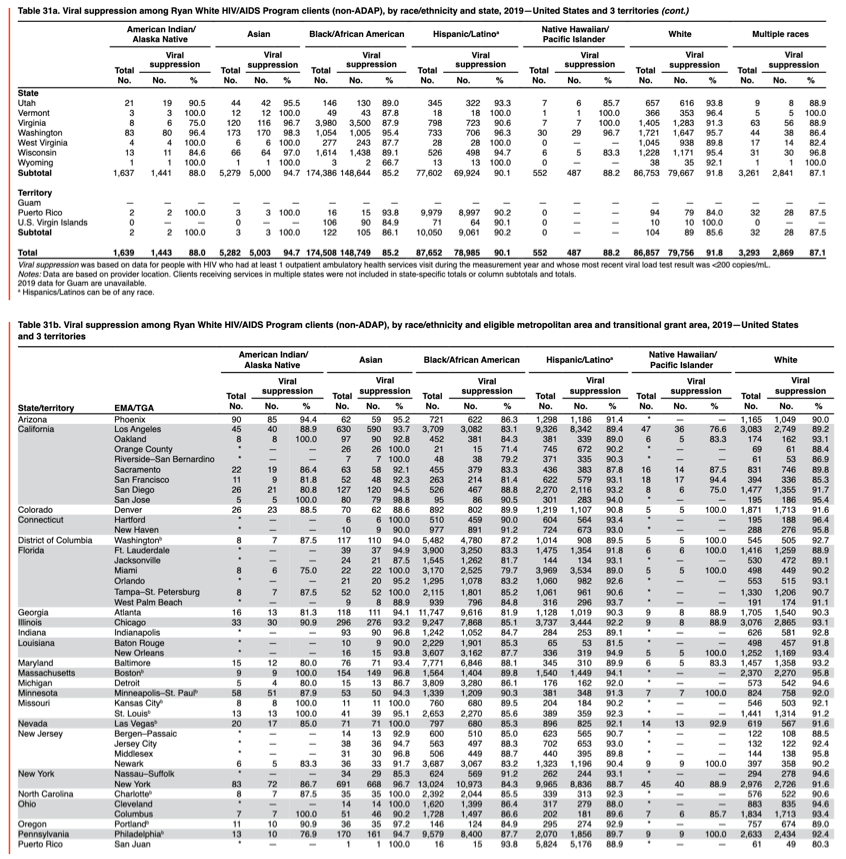| |
Disparities in HIV Viral Suppression in the USA
|
| |
| |
While new HRSA data reports 88% in RW clinics have viral suppression the key data in this report is the continued disparity in viral suppression between Black/African-Americans and whites. This disparity is all too often overlooked and is stark as well when looking published Medicare data showing African-Americans & Latinos experience 3-4 times higher rates of Comorbidities. Below are tables from the HRSA report and a link to the actual report. It certainly is good that viral suppression rates are 88% overall but look at the disparities in the tables below, by State, city, ethnicity and other factors. The CDC has reported 60% viral suppression rates reflecting the many PLWH in the USA who are not engaged in care actively & the CDC and others have looked at durable viral suppression rates, which are lower & more important than a single viral test which is suppressed. In this HRSA report durable suppression is not well delineated. Why are these disparities not getting adequate attention, this has persisted since 1996. PLWH & those aging with HIV do not need PrEP, cure is a hope that may not be attained or might be 20 years hence so is not a great & real hope for PLWH over 65. PLWH over 65 feel abandoned, ignored - want improved care, research & services but do not get any attention or real change. Jules Levin, NATAP
Retention in care and viral suppression data for the RWHAP should be interpreted carefully. RSR client-level data are reported on an annual basis and are de-identified when reported. As a result, client-level data cannot be linked across years, which affects how HIV-related outcomes are calculated for this report. Specifically, retention in care is measured among RWHAP clients with HIV who received at least one outpatient ambulatory health services (OAHS) visit before September 1 of the calendar year (i.e., January 1 through August 31) to allow a second care visit to occur at least 90 days later during that calendar year. Viral suppression is calculated for the full calendar year and is measured specifically among RWHAP clients who received at least one OAHS visit during the calendar year and who had at least one viral load test result reported; that is, viral suppression is among people with HIV who received medical care by RWHAP providers during the year and had at least one viral load test.
[of note, CDC has reported 60% are virally suppressed in USA, this reflects PLWH not in regular engaged care compared to RW clinics; viral suppression is often measured by several visits of viral suppression, thus not only 1 visit where viral suppression is measured but several in a row to get a much better sense of continuity. At CROI 2020, a study from Atlanta found Black MSM to be 60% less likely to be virally suppressed and found 5 modifiable risk factors that could be targeted to reduce this disparity: http://www.croiwebcasts.org/console/player/44835?mediaType=audio&
As a result of the above specifications about the retention in care and viral suppression calculations, the numbers of people with HIV included in these analyses are not equal to the total number of people with HIV served by the RWHAP; the subset of clients for retention in care analyses is approximately 63% of the total RWHAP client population with HIV, and the subset for viral suppression is approximately 67%. Clients who are not included in retention in care or viral suppression calculations may have received any other RWHAP service (e.g., Medical or Non-Medical Case Management
https://hab.hrsa.gov/sites/default/files/hab/data/datareports/RWHAP-annual-client-level-data-report-2019.pdf
Retention in Care and Viral Suppression Among Key Populations
This section reviews overall retention in care and viral suppression in 2019 for each key population and highlights the subpopulations with the lowest percentages. Generally, this includes subpopulations with outcomes at least 5 percentage points lower than that of the overall key population. Data for subpopulations with numbers less than 100 are not included in the highlights because of the variability in percentages resulting from small numbers.
Black/African American women (Tables 11a/b): Overall, the percentages of Black/African American women who were retained in care (82.3%) and virally suppressed (86.7%) were relatively consistent with the national RWHAP averages (80.8% and 88.1%, respectively). Among Black/African American women, retention in care was lower within certain demographic subgroups, including those aged 25-29 years (75.4%) and 30-34 years (76.2%) and those in HHS Regions 6 and 10 (77.3% and 76.6%, respectively; see Technical Notes for states/territories included in each region), and those with unstable housing (77.0%). Percentages of viral suppression among Black/African American women were lower among those in each 5-year age group from 15 to 34 years (range: 70.9%-81.0%), those with perinatally acquired HIV (72.2%), and those with temporary (81.2%) or unstable housing (75.7%).
Black/African American men (Tables 12a/c): The overall percentage of Black/African American men who were retained in care (78.8%) was relatively consistent with the national RWHAP average (80.8%), but the percentage of those who achieved viral suppression was slightly lower (84.5%) than the average (88.1%). Among Black/African American men, retention in care was lowest among those aged 25-29 years (72.8%) and 30-34 years (73.3%), those in HHS Regions 6 and 9 (72.8% and 73.5%, respectively), and those with temporary (73.5%) and unstable (73.3%) housing. Viral suppression was lowest among Black/African American men in each 5-year age group from 15 to 29 years (range: 75.4%-78.2%), those with perinatally acquired HIV (73.6%), those with no health care coverage (77.6%), and those with temporary (78.6%) or unstable (72.4%) housing.
You see in Table 12c Black/African-Americans men have lower viral suppression rates than hispanic & whites, as much as by 7-10 percentage points in younger age groups, hispanics rates are more similar to whites. As well in table 12d., Black/African-American women have lower rates if viral suppression but more specifically in certain young age groups compared to whites. In Table 31a & 31b below you will see the same differences by State & by City.




|
|
| |
| |
|
|
|